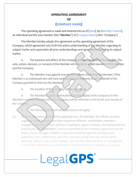The SaaS Contract Mistakes That Cost Companies Millions
Software-as-a-Service contracts have become the backbone of modern business operations. Yet a single overlooked clause can transform your helpful...
6 min read
LegalGPS : Nov. 12, 2025
Software has become the backbone of modern business operations. From customer relationship management to accounting systems, companies rely heavily on third-party software solutions to run efficiently. But what happens when the company behind your critical software suddenly shuts down?


Legal GPS Pro
Protect your business with our complete legal subscription service, designed by top startup attorneys.
The reality is more common than most entrepreneurs realize. Software companies, especially smaller startups and niche providers, face significant challenges in today's competitive market. When they fail, the businesses that depend on their products can face serious operational disruptions, data access issues, and unexpected costs.
Understanding the potential consequences and preparing for this scenario can mean the difference between a manageable transition and a business-threatening crisis. This guide will walk you through everything you need to know about vendor failure and how to protect your operations.

Software Source Code Escrow Agreement
Use our Software Source Code Escrow Agreement Template to safeguard business continuity by having source code and related materials securely deposited with a neutral third party.
Trusted by 1,000+ businesses to safeguard their LLCs.
Software companies fail for various reasons, and understanding these factors can help you assess the risk level of your current vendors. Market competition often drives smaller companies out of business when larger competitors offer similar solutions at lower prices or with better features.
Financial difficulties represent another major cause of software vendor failures. Many software companies operate on thin margins, especially in the early stages. When subscription renewals decline or major clients leave, cash flow problems can quickly escalate to bankruptcy.
Technical debt and outdated infrastructure also contribute to vendor failures. Companies that fail to modernize their platforms may find themselves unable to compete with newer, more efficient solutions. The cost of updating legacy systems can become prohibitive, leading to business closure.
TechStart Solutions provided cloud storage services to over 2,000 small businesses for three years. When Amazon Web Services lowered their prices significantly in 2019, TechStart couldn't compete and gave customers only 30 days' notice before shutting down. Businesses scrambled to migrate terabytes of data, with some losing important files due to the rushed timeline.
When a software vendor suddenly announces closure, the immediate effects on your business can be severe. Access to critical systems may be terminated with little warning, potentially halting daily operations that depend on that software.
Data access becomes a primary concern. If your vendor hosts your data on their servers, you may lose access to years of customer information, financial records, or project files. The urgency of extracting this data often leads to hasty decisions and potential data loss.
Maintain an updated list of all software systems, their primary functions, and alternative access methods. Include administrator credentials, export procedures, and backup locations. Review this documentation quarterly to ensure accuracy when you need it most.
Customer service disruptions can damage your reputation and revenue. If your customer support system goes offline, you may be unable to respond to client inquiries or process orders, directly impacting your bottom line.
Understanding your legal rights when a software vendor fails is crucial for protecting your business interests. Software license agreements typically contain specific clauses addressing vendor bankruptcy or business cessation.
Most commercial software licenses include termination clauses that outline what happens to your usage rights when the vendor ceases operations. However, these clauses often favor the vendor and may leave you with limited recourse.
Marketing firm Creative Solutions paid $12,000 annually for a project management platform. When the vendor filed for bankruptcy in month eight of their contract, the terms stated no refunds for unused services. Creative Solutions lost $4,000 and had to purchase new software immediately to maintain client projects.
Escrow agreements represent one of the strongest protections for businesses using critical software. These agreements require vendors to deposit source code and documentation with a third party, ensuring access if the company fails.
Some jurisdictions provide consumer protection laws that may apply to software purchases, particularly for small businesses. These laws can sometimes override unfavorable contract terms and provide avenues for compensation.
Proactive protection starts with careful vendor selection and ongoing monitoring. Research your software vendors' financial stability by reviewing their funding history, customer base size, and market position.
Diversification reduces your risk by avoiding over-dependence on any single vendor. When possible, use multiple software solutions for critical functions or choose platforms that integrate well with alternatives.
Accounting firm Henderson & Associates learned from their colleagues' experience with a failed invoicing software company. They now use QuickBooks as their primary system while maintaining a secondary account with Wave Accounting. This dual setup requires minimal additional cost but provides complete backup capability.
Regular data backups are essential regardless of vendor stability. Implement automated daily backups of all critical data stored in third-party systems, and test these backups monthly to ensure they're functional.
Contract negotiations should include specific protections for vendor failure scenarios. Request clauses requiring advance notice of business difficulties, data transition assistance, and prorated refunds for unused services.
Set up Google Alerts for your critical software vendors to monitor news about financial difficulties, lawsuits, or major customer losses. Early warning signs can give you valuable time to prepare contingency plans.
The first 48 hours after learning about vendor closure are critical for protecting your business. Immediately export all accessible data from the failing system, prioritizing customer information, financial records, and active project files.
Contact the vendor directly to understand the shutdown timeline and available transition support. Many companies provide limited assistance during closure periods, but this support often operates on a first-come, first-served basis.
Document everything related to your relationship with the failing vendor, including contracts, payment records, and outstanding service credits. This documentation may be necessary for insurance claims or legal proceedings.
When inventory management software company StockTrack announced closure with 14 days' notice, restaurant chain Local Eats immediately assigned two staff members to data extraction. They successfully exported three years of inventory data and supplier information within 72 hours, avoiding disruption to their supply chain operations.
Communicate transparently with affected stakeholders, including employees, customers, and business partners. Explain the situation and your planned response to maintain confidence in your business continuity.
Research and evaluate replacement solutions quickly but carefully. Create a shortlist of alternatives and prioritize platforms that can import your exported data with minimal modification.
Recovery from vendor failure requires both immediate action and long-term strategic planning. Focus first on restoring essential business functions, even if temporarily using less optimal solutions.
Data migration represents the most complex aspect of vendor transition. Plan for this process to take longer than expected and require more resources than initially estimated. Consider hiring specialists if your team lacks technical expertise.
When CRM provider CustomerFirst shut down suddenly, law firm Peterson & Williams initially used spreadsheets to track client information. Over six months, they carefully migrated to Salesforce, customizing the platform to match their workflow. The transition ultimately improved their client management capabilities beyond what CustomerFirst had provided.
Staff retraining becomes necessary when switching to new software platforms. Budget for this training and consider the productivity impact during the learning period.
Financial recovery may involve pursuing compensation through vendor bankruptcy proceedings or insurance claims. Maintain detailed records of all costs related to the vendor failure, including lost productivity, migration expenses, and temporary solution costs.
Use vendor failure as an opportunity to reassess your entire software stack. Often, newer alternatives offer improved features, better integration, or lower costs than the failed system. What feels like a crisis may ultimately lead to better business operations.
Long-term business resilience requires strategic planning that anticipates vendor failures. Develop a vendor risk assessment framework that evaluates financial stability, market position, and alternative availability for all critical software providers.
Create standardized data export procedures for all major systems. Test these procedures annually to ensure they work when needed and that exported data is complete and usable.
E-commerce company GearUp Outdoors structures their operations using best-of-breed solutions with strong API connections. Their inventory system, payment processing, and customer service platforms all integrate through standardized APIs. When their shipping software vendor was acquired and discontinued, they switched providers in just five days without disrupting operations.
Maintain emergency vendor contact information and escalation procedures. Establish relationships with alternative software providers before you need them, including trial accounts or preliminary contracts that can be activated quickly.
Regular business continuity planning should include vendor failure scenarios. Run annual exercises that simulate major vendor shutdowns and test your response procedures.
Insurance considerations may include business interruption coverage that specifically addresses software vendor failures. Consult with your insurance provider about available options and coverage limits.
Software vendor failures are an inevitable risk in today's technology-dependent business environment. The key to surviving these situations lies in preparation, quick response, and strategic recovery planning.
Start by assessing your current vendor risks and implementing basic protections like regular data backups and contract improvements. Monitor your vendors' health proactively and maintain relationships with alternative providers.
When vendor failure occurs, act quickly to preserve your data and business continuity. Focus on immediate operational needs while planning for long-term improvements to your software infrastructure.
Remember that vendor failure, while disruptive, can also provide opportunities to upgrade your operations and build more resilient systems. The businesses that prepare for these scenarios often emerge stronger and more competitive.
Ready to protect your business from software vendor risks?
Legal GPS offers professionally drafted vendor agreements and business continuity templates that include specific protections for vendor failure scenarios. Our Pro subscription provides access to comprehensive contract templates that can help safeguard your operations before problems arise.

Legal GPS Pro
Protect your business with our complete legal subscription service, designed by top startup attorneys.
|
Premium Template
Single-use Template |
Legal GPS Pro
Unlimited Access, Best Value |
|
|
| Choose Template | Learn More |
| Trusted by 1000+ businesses | |
Table of Contents

Software-as-a-Service contracts have become the backbone of modern business operations. Yet a single overlooked clause can transform your helpful...

Starting an online store is an exciting venture, but it comes with its own set of legal challenges that you need to address to keep your business...

The e-commerce boom has created incredible opportunities for entrepreneurs to build thriving online businesses. However, beneath the surface of every...